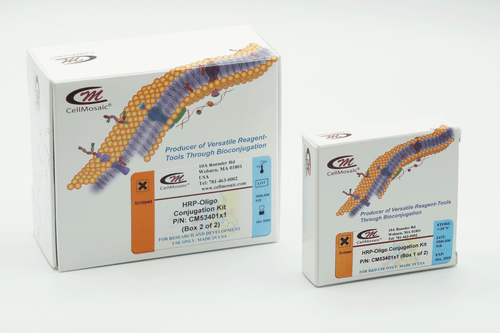Product Description
CellMosaic® has designed this Streptavidin-oligo conjugation kit with linkers and conjugation chemistry that retain the activity of Streptavidin.
| Download Documents | |
| SDS | USER MANUAL |
This PerKit® is designed for single-labeled streptavidin-oligo conjugation using click chemistry. The kit is designed to work with DBCO-modified oligos with multiple configurations to accommodate various oligo lengths. The user supplies the DBCO-modified oligos, which are readily available from many commercial oligo suppliers. Using the kit components, the user can react the DBCO-oligo with azide-activated streptavidin in a single step to generate streptavidin-oligo conjugates. The total length of the linkage between the streptavidin and DBCO-oligo is 16 atoms. The Q-column purification step typically provides the resulting Streptavidin-oligo at greater than 80% purity.
This kit provides materials to perform one or three strepatavidin and DBCO-oligo conjugation(s). Scale of the reaction: 2 to 5 nmol oligo.
Table 1: Configurations of the PerKit™ Streptavidin-Oligo conjugation kit (CM52427)
|
Configuration |
No. of Reactions |
Catalog No. |
|
1. Labeling for short oligo (5−30 bases) |
1 |
CM52427.1x1 |
|
3 |
CM52427.1x3 |
|
|
2. Labeling for medium oligo (≥30 bases) |
1 |
CM52427.2x1 |
|
3 |
CM52427.2x3 |
Requirements for DBCO-Oligo:
- Total Amount: 2 to 5 nanomoles of oligo, as measured by UV
- Purity: HPLC purified, with DBCO-oligo content ≥90% as measured by C18 HPLC.
- Length: Minimum of 5 bases (Note: Oligos longer than 60 bases lead to lower loading efficiency and increased impurities).
Note: HPLC-purified DBCO-modified oligos, up to 90 bases in length, can be purchased from standard oligo manufacturers for this kit prparation. It is highly recomended that customers analyze and quantify oligos prior to use. If customers fo not have access to C18 HPLC in their lab they can send samples to CellMosaic for Analysis.
Key Features of this Streptavidin-Oligo Conjugation Kit:
-
High quality azide-activated streptavidin for single labeling.
-
A single purification affords 85-90% single-labeled streptavidin-oligo conjugates if the quality of the oligo is at par.
- Preparation can be done in a day.
- Stable linkage with optimal spacer to ensure no interference between oligo binding and streptavidin activation.
-
All reagents included, from preparation to purification.
- Options to choose tailored services at CellMosaic® after conjugation
After conjugation: you can choose to send your sample to CellMosaic® for size-exclusion chromatography (SEC) and anion exchange (AEX) HPLC Analysis.
SEC HPLC separates the conjugates by apparent molecular weight (MW) or size in aqueous solution. The larger the MW of the conjugate, the earlier it elutes.
AEX HPLC separates the components according to the negative charges of the molecule.
You can also send your conjugates to CellMosaic for a complete removal of trace oligo impurities and unreacted streptavidin.
Labeling Chemistry

Typical Kit Performance Data (LC Analysis, CellMosaic)
Oligo information: HPLC-purified 23mer oligo with 5’ DBCO modification
Kit Lot Number: Box 1 (S553.S8.1104D) and Box 2 (S553.S7.1104D)
Figure 1: Overlay of Size-exclusion (Gel-filtation) HPLC profiles of Activated Streptavidin (green trace), oligo (red trace), and purified Streptavidin-Oligo Conjugate (E1) (blue Trace) detected at 220 nm. Size-exclusion chromatography (SEC) separates conjugates based on their apparent moecular weight (MW) or size in aqueous solution, with large MW eluting earlier.

Figure 2: SEC HPLC of purified streptavidin-oligo conjugate detected at 220 nm.

Table 1: Summary results
| Sample | Volume µL | % free Streptavidin | % free oligo (non-DBCO impurities) | % of Streptavidin/oligo (1:1) |
| E1 (first elution) | 400 | Not detected | 2 | >97.9% (90.5% of 1:1 Conjugates) |
Frequently Asked Questions:
If you can’t find the answer you’re looking for or need information on general topics, please visit the main Frequently Asked Questions (FAQs) section.
















